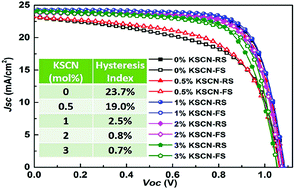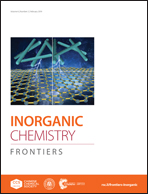A potassium thiocyanate additive for hysteresis elimination in highly efficient perovskite solar cells†
Abstract
Organic–inorganic hybrid perovskite solar cells, which are regarded as the most promising candidate for next-generation photovoltaic cells, have achieved extremely high power conversion efficiencies of over 23%. However, hysteresis, characterized as an inconsistent power output under varying electric fields, hinders their progress towards commercialization. In this paper, by introducing potassium thiocyanate into the perovskite precursor solution, we have successfully obtained a highly efficient methylammonium lead iodide (MAPbI3) perovskite solar cell with no hysteresis. The incorporation of potassium thiocyanate immensely enhances the crystallinity of MAPbI3 with lower defect density and longer carrier lifetime. The grain size increases to over 600 nm due to the positive synergy of potassium ions and thiocyanate ions, which is more than three times compared with that of the control sample. Decreased series resistance and increased recombination resistance reveal faster charge transport and less carrier recombination, respectively, contributing to hysteresis elimination. At the optimum concentration of the potassium thiocyanate additive, the perovskite solar cell achieves a high conversion efficiency of 19.6%.



 Please wait while we load your content...
Please wait while we load your content...